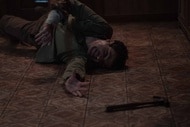The 'Saw' horror franchise's twisty, spiraling timeline explained
Making sense of the Saw franchise, before Jigsaw catches us.

It's never a bad time to revisit one of the scariest, goriest horror franchises in modern history — so with a big chunk of the Saw franchise now streaming on Peacock — we take a deep dive into making sense of the twisty, tricky Jigsaw continuity that ties it all together. To date, the Saw films have a lengthy history of making us squirm in our seats through nine brutal films stretching all the way back to 2004.
With that much mayhem and destruction, it feels like a good idea to remind ourselves how we got here. If you're looking to relive the best traps and deaths, Saw II (2005), Saw III (2006), Saw IV (2007), Saw V (2008), Saw VI (2009), Saw: The Final Chapter (2010) and Jigsaw (2017) are all streaming now on Peacock.
It would be impossible to contain every twist, every trap, every demented game from the franchise in a single summation, but we're going to hit the major beats and the overall vibe of the series along the way. Let's dive into this little game, and of course be warned that there are spoilers for the entire series so far below.
THE JIGSAW KILLER
Saw, the first film in the series, takes its name from a pair of hacksaws that form a crucial piece of its intimate, nerve-shredding plot, but also from The Jigsaw Killer, a name given to a particularly mischievous murderer so named because of his tendency to carve puzzle piece-shaped chunks of skin out of his victims. In this first film, which largely revolves around the saga of two men (Cary Elwes and Leigh Whannell, who also wrote the film) trying to escape from a single dingy room, we get several of the key hallmarks of the saga at once. Saw, we learn, is a place where we should expect brutal death traps, tense morality plays, characters who often mean more than they seem to at first glance, and of course, twist endings.
It is through the franchise's very first twist ending that we discover the Jigsaw Killer's real identity. John Kramer (Tobin Bell) is a brilliant engineer who has developed a particularly potent philosophy that drives his killings. He believes there are people in the world who are suffering needlessly and hurting others needlessly because they don't value life enough, a feeling bolstered by his terminal brain cancer diagnosis. So, he abducts his victims and places them in "games" or "tests," elaborate traps that require them to do something violent, sacrificial, and horrible if they want to escape and survive. The key component here, of course, is that John actually has faith that people will change if they survive the test and learn the value of life, so his subjects are always given an opportunity to escape, even if it means they have to do something like lose a limb or, in some cases, kill another person.
Once we get to the point of John's reveal as the killer, even when we're talking about the first sequels in the franchise, it's better to think of Saw continuity not as a straight line but as an increasingly complex knot, looping back over itself, circling around from the past to the present, and growing more and more twisted as time goes on. This is because, over the course of the series, John Kramer adopts several people, including former test subjects, as his apprentices and allies, and while he's present in some form in every single film so far, these apprentices are often put front and center in the sequels.
THE PROTÉGÉS
The first of these is Amanda Young (Shawnee Smith), a character introduced in Saw as the only known survivor of a Jigsaw game to that point, and who re-emerges as an apparent victim in Saw II only to be revealed as John's accomplice by the end. A drug addict who truly believes John saved her life by teaching her the value of it again, Amanda becomes John's apprentice as his cancer worsens, but while she's the heir apparent to Jigsaw, the two share some philosophical differences. In Saw III, it's revealed that Amanda has begun rigging her games to make them essentially inescapable, removing a key tenet of John's work, which he eventually discovers. In his dying days, he makes Amanda part of another test, which ultimately kills her.
By the end of Saw III, both Amanda and John are dead, paving the way for a new Jigsaw heir in the form of Detective Mark Hoffman (Costas Mandylor). Unlike Amanda, Hoffman was not drawn to Jigsaw's side after one of his games. Instead, Jigsaw found Hoffman after the detective rigged up his own Jigsaw copycat game to kill the man who'd murdered his sister. John was, of course, not happy with this, and captured and blackmailed Hoffman into helping set up many of the traps in the previous films. Saw IV, most of which takes place concurrent to Saw III, set up the beginning of Mark's own reign of terror as the killer, with none of the hopeful attachment John himself had to his philosophy.
Of course, by the end of Saw IV, John has posthumously threatened Mark with a test of his own, and it's something that unfolds over the course of Saw V, Saw VI, and Saw 3D as Mark tries to carve out his own place as a killer, tying up the loose ends of law enforcement on his tail. Ultimately, the real retaliation comes through John's ex-wife, Jill (Betsy Russell) whose miscarriage following an accident involving a careless addict helped drive John to become Jigsaw. In Saw V, Jill receives a box of instructions and victim names as part of John's final game. Though she gives most of the names to Hoffman, the final piece of the puzzle is Hoffman himself. John always intended to test him, and Jill follows through on that wish by placing him in a trap that he only narrowly escapes.
Hoffman gets his revenge on Jill in Saw 3D, killing her, but in the process, he activates a fail-safe John put in place years earlier in the form of Lawrence Gordon (Cary Elwes), a Jigsaw survivor from the very first film who was helped by John after his escape. John and Lawrence ultimately formed a bond, and one of John's parting wishes was that Lawrence would act if anything ever happened to Jill. Thus, Lawrence locked Hoffman in the room where the franchise all started, seemingly leaving him for dead.
So with John, Jill, Amanda, and Mark dead, it would seem the franchise is out of Jigsaws, right? Wrong, because that's where 2017's Jigsaw comes in. The most recent entry in the franchise spends a lot of time on an elaborate Jigsaw game in a barn, only to then reveal that most of what we've seen has taken place 10 years in the past, and the lone survivor of that game is actually John Kramer's very first apprentice, Logan Nelson (Matt Passmore). Logan, a medical examiner by day, uses his twisty Jigsaw knowledge to capture a confession and then frame and murder a fellow cop, leaving the door open for even more games from him in the future.
FROM THE BOOK OF SAW
Which of course brings us to the question of what any of this may or may not have to do with the most recent film, 2021's Spiral. The latest film follows a cop, played by Chris Rock, as he investigates a Jigsaw copycat killer, reviving some of Jigsaw's old trademark tricks.
If you take nothing else away from this trip down memory lane today, take this: When it comes to the Saw franchise, expect the unexpected.
Saw II (2005), Saw III (2006), Saw IV (2007), Saw V (2008), Saw VI (2009), Saw: The Final Chapter (2010) and Jigsaw (2017) are all streaming now on Peacock.


























